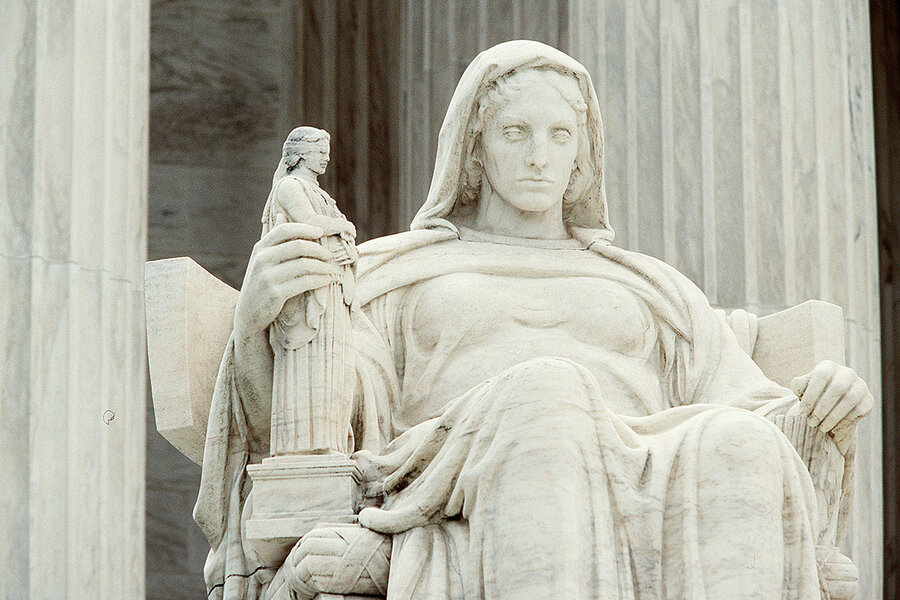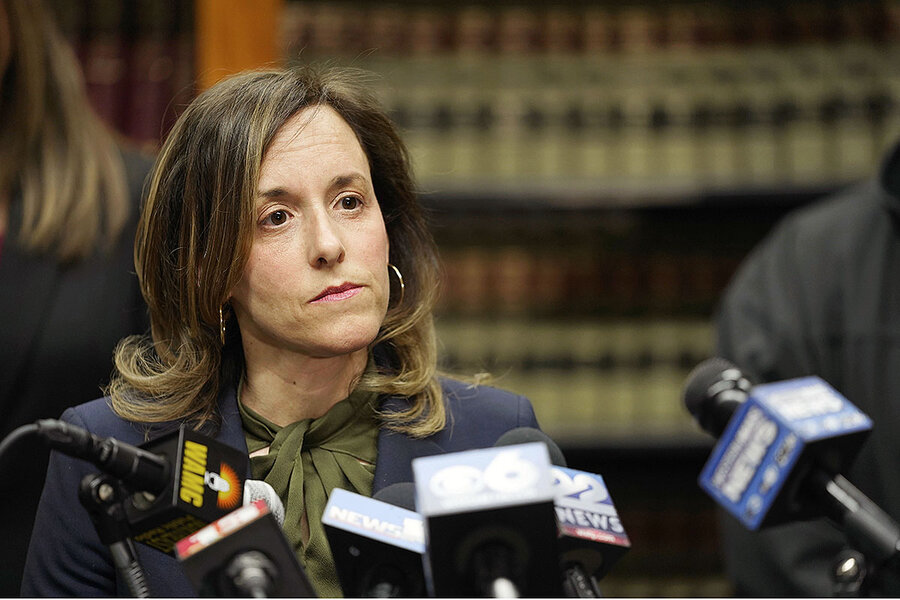A step toward better justice: Prying open the ‘black box’ of plea deals
Loading...
| Irving, Texas
Roughly 95% of criminal cases in the United States are resolved via plea bargain, according to the Department of Justice. What’s more, they happen almost entirely in secret, often negotiated out of sight of a judge and always out of sight of a jury of peers.
Innocent defendants can be pressured into making confessions before even seeing a lawyer. And if a defense lawyer does get to meet their client, prosecutors can make compelling plea offers before that lawyer has time to investigate the case, file motions, or even get to know the client. Plea offers can also be made, and accepted, before discovery, when prosecutors share evidence – including potentially exculpatory evidence – with the defense.
Why We Wrote This
Plea bargaining is a largely secret process that doesn’t always do justice to the defendant or the victim. But efforts are underway to bring it out of the shadows – a first step in improving it.
Hoping to make the process fairer and more transparent, some prosecutor offices are working with academics to pry open the “black box” of plea bargaining.
Since last April, researchers at Duke University have been helping prosecutor offices in Durham County, North Carolina; and Berkshire County, Massachusetts, document felony plea negotiations more thoroughly.
“We have a mammoth in the room,” says Martín Sabelli, president of the National Association of Criminal Defense Lawyers. Having more data, he adds, “will help us understand more the nature of the beast.”
Last year, in Berkshire County in Massachusetts, local prosecutors charged two white men arrested in separate cases with assault and battery. Both were in their 30s, neither had any prior criminal history, and both cut deals in exchange for pleading guilty.
But their deals differed significantly, despite the similarity of their cases. One man received a short probation sentence that included rehabilitation services; the other received a long probation sentence and fines.
Roughly 95% of criminal cases around the country are resolved via plea bargain, according to the Department of Justice. “Criminal justice today is for the most part a system of pleas, not a system of trials,” wrote U.S. Supreme Court Justice Anthony Kennedy in a 2012 opinion. What’s more, they happen almost entirely in secret, often negotiated out of sight of a judge and always out of sight of a jury of peers.
Why We Wrote This
Plea bargaining is a largely secret process that doesn’t always do justice to the defendant or the victim. But efforts are underway to bring it out of the shadows – a first step in improving it.
Now, some prosecutor offices are working on prying open the “black box” of plea bargaining. Hoping to make the process fairer and more transparent, they’re partnering with academics to track data related to their plea deals. Other prosecutors are trying to reduce the number of bargains they make.
Though far removed – perhaps too far removed – from the vision at America’s founding of a justice system built on a robust right to trial by jury, plea bargaining will likely always be needed. But there is now an increasing demand to improve the process.
“We have really needed this kind of data, this kind of research, for a long time,” says Ronald Wright, a professor at Wake Forest University School of Law who researches criminal prosecutors. “It’s groundbreaking.”
“We know about the outcomes [of plea bargains], and we know something about the inputs,” he adds. But the middle of the process, “all the formulations that go into making the offers, we’ve been blind to that for more than a century.”
“We want to be able to be transparent”
Plea negotiations mostly hinge on prosecutorial discretion. Their bail recommendation, for example, could keep a defendant in jail, thereby ratcheting up pressure to accept a plea. Another example is threatening more serious charges if a defendant refuses to accept a plea, known in the legal community as the “trial penalty.”
Outside of the fact that almost all criminal cases are resolved through plea bargains, very little is known about them – including inside prosecutor offices themselves. But since last April, researchers at Duke University have been helping prosecutor offices in Durham County, North Carolina; and Berkshire County, Massachusetts, document felony plea negotiations more thoroughly. Both district attorneys – Satana Deberry in Durham and Andrea Harrington in Berkshire – were elected a few years ago after promising progressive reforms to their offices.
In Durham, researchers’ preliminary findings have revealed that 79% of felony cases involved only one plea before the offer was accepted, and that the vast majority of defendants who accepted pleas were people of color (though the office didn’t specifically track demographic information).
Formal, written plea offers are rarely revised, the researchers wrote in a report published last year. And “Alford pleas,” which contain a formal claim of innocence, are extremely uncommon. Defendants who accepted plea deals averaged around a decade less prison time than the maximum possible sentence for that category of crime. (Note: that maximum sentence would be reserved for people with lengthy criminal histories.) But the researchers added that they “lacked information concerning the reasoning of prosecutors for selecting plea options.”
“We want to be able to be transparent. We want to be able to tell our community what we do, who we’re prosecuting. We want to be able to be fairer,” says Ms. Deberry.
There is less data out of the Berkshire County office so far, but the information has encouraged prosecutors to have more contact with victims, Ms. Harrington says. It also suggests that her office is achieving one of her goals: sending more defendants to appropriate treatment programs.
In addition, under Massachusetts law, judges can reject or make changes to plea agreements, and the Duke researchers write that the plea tracker “could eventually shed light on how the judges and defense counsel influence case outcomes in Massachusetts.”
Looking ahead, Brandon Garrett, a professor at Duke University School of Law and leader of the project, says he and his colleagues will begin working with another local prosecutor office in Utah this spring. They also hope to partner with public defender offices this year and collect plea bargaining data from their side.
“Besides studying patterns, we want lawyers to do good work. Typically people do better work if there are steps to follow, if there are best practices,” Professor Garrett says.
“I firmly believe documenting the plea process will be seen as something any ethical lawyer does 10 years from now,” he adds, “even if no office had done it before a year ago.”
The plea tracker has also allowed Ms. Harrington to see why those two men in their 30s received such different sentences: The man with the longer sentence was believed to pose a higher risk of recidivism, she wrote in a Boston Globe op-ed; for the man with the shorter sentence, the prosecutor wanted to ensure his mental health needs were addressed.
“I know we’re going to see problems. I know we’re going to see things that we need to address,” she adds. “We can’t fix things that we don’t necessarily understand.”
When pleas don’t deliver justice
The rampant and uneven nature of plea bargaining has had severe consequences for defendants and victims alike.
In 2002, for example, Christopher Ochoa was exonerated after 13 years in prison for the rape and murder of a young woman. He had confessed to the murder after more than 12 consecutive hours of police interrogation, and pleaded guilty in order to avoid the death penalty.
And last week a woman in Baltimore complained publicly about attempted murder charges against her ex-boyfriend being dropped as part of a plea bargain, despite his having set her house on fire while she and her roommates slept inside.
“Plea bargaining is rapidly becoming a system of ultimatums delivered by prosecutors, rather than real negotiation,” says Martín Sabelli, president of the National Association of Criminal Defense Lawyers.
As in Mr. Ochoa’s case, innocent defendants can be pressured into making confessions before even seeing a lawyer. If a defense lawyer does get to meet their client, prosecutors can make compelling plea offers before that lawyer has time to investigate the case, file motions, or even get to know the client. Plea offers can also be made, and accepted, before discovery, when prosecutors share evidence – including potentially exculpatory evidence – with the defense.
“I get some plea offers the first day I meet my client,” says Mr. Sabelli. “[Defendants] just break under the threat of the trial penalty.”
“It fundamentally undermines the vision of the framers, and fundamentally undermines our basic sense of justice,” he adds.
Having a guilty defendant accept responsibility for their crimes is important not just for a sense of justice, but for the individual’s rehabilitation, says Paul Heaton, academic director of the Quattrone Center for the Fair Administration of Justice at the University of Pennsylvania Carey Law School.
But pleas often don’t even mention the crime that occurred. “In reality what usually happens is you’re not pleading out to what actually happened,” but to a lesser charge, Mr. Heaton says.
Managing the “mammoth in the room”
The right to a trial by jury is as old as America itself – and was of particular importance for the framers, who felt the visibility of the process would help ensure that a citizen’s rights are protected.
But as the legal system grew increasingly professionalized, plea bargaining became more common. And as the war on drugs escalated, flooding the system with new cases to prosecute, pleas became the only way the system could continue to function. But the framers’ vision of a justice system in full view of the public has been eroded in the process.
No one is seriously advocating for a return to the Colonial-era jury trial-only system, but some prosecutors – like Utah County Attorney David Leavitt, a Republican; and newly elected Manhattan District Attorney Alvin Bragg, a Democrat – are starting to reduce the number of plea bargains they negotiate.
Given the sheer volume of cases that move through the U.S. criminal justice system every day, plea bargaining will continue to be necessary. But across the ideological spectrum – the American Civil Liberties Union and the libertarian Cato Institute are but two examples – many agree that plea bargains can be fairer and more transparent, and shouldn’t be coercive.
Before corrections can be made, however, the full extent of the problems in the plea process needs to be researched.
“We have a mammoth in the room. We can kind of see it, but we can’t see every part of it,” says Mr. Sabelli. Having more data, he adds, “will help us understand more the nature of the beast.”
Clarification: This article has been updated to reflect that maximum possible sentences would be handed down to defendants with lengthy criminal histories.









